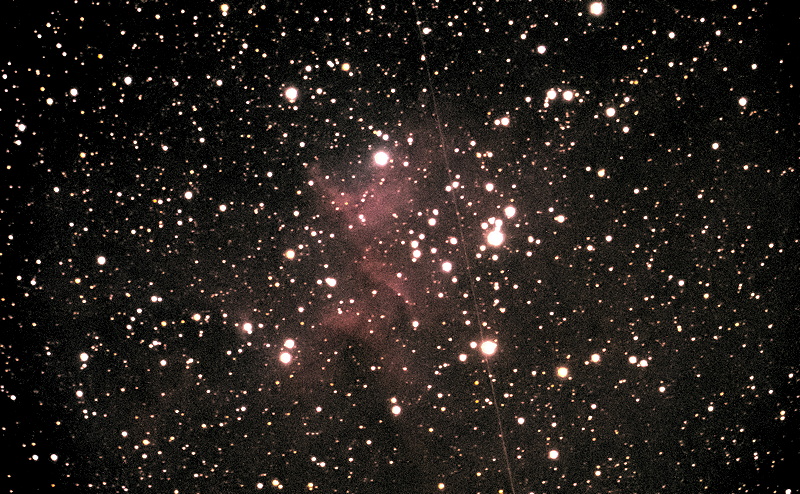Western Sky; Persistent Packrat;
Cassiopeia Nebulae
Posted: 12 September 2018
|
Open: Tuesday, 11 September 2018, 1824 MST Temperature: 85°F |
Session: 1276 Conditions: Clear |
Equipment Used:
12" f/8 LX600 w/StarLock
2" 24mm UWA eyepiece
Focal Reducer
Camera:
D850 DSLR
1833 MST: LX600 ON, StarLock OFF, High Precision OFF.
Viewed Venus, 102X.
1837 MST: sunset.
Viewed the crescent Moon, 102X.
Stepped outside of the observatory and took this photo showing the observatory, Venus (faintly visible), and the crescent Moon (f/5.6, 1/60sec, ISO 400, FL 36mm):

Returned to the observatory and mounted the D850 DSLR at prime focus of the 12" telescope to image the crescent Moon (1/60sec, ISO 400):

1911 MST: western sky and the observatory (f/2.8, 1/20sec, ISO 1600, FL 35mm):

Mouseover or tap on image for labels
1920 MST: viewed the Moon and Earthshine, 102X.
Then viewed some planets, 102X: Jupiter and four moons; Saturn and four moons; and Mars with South Polar Cap, North Polar Hood, and a dark surface area all visible.
1933 MST: began preparing to image some nebulae for my Cassiopeia Constellation Astrophotography Album. Mounted the D850 DSLR at prime focus, focused and SYNCed on the star Shedir in Cassiopeia, and locked the mirror.
1947 MST: heard the packrat again this night outside of the observatory beneath the POD Zenith Table (PZT). Stepped outside and got this iPhone photo:

I then began imaging nebula. These images were all StarLock autoguided, 5 minutes, ISO 6400, White Balance 5000K. Sometimes all does not go as hoped, as seen in the first photo of NGC281 (the Pacman Nebula) when a satellite crossed right in front of the nebula. Grrr.
NGC281 (Pacman Nebula); unedited

NGC281 (Pacman Nebula); edited and cropped

NGC7635 (Bubble Nebula); edited and cropped

IC1805 (Heart Nebula); edited and cropped (and another satellite)

IC1848 (Soul Nebula); edited and cropped

Between imaging I used the 12x50 binoculars to look at the Double Cluster, and the galaxies M31, M32, and M110 (all part of the Andromeda Galaxy).
2040 MST: the packrat was back. I pounded on the PZT and the bays, but that didn't seem to bother him. Rotating the dome did seem to scare him off, at least temporarily. I will probably have to set out a trap to capture him and relocate him.
I removed the focal reducer, refocused on Shedir, and locked the mirror for this StarLock autoguided, 30 seconds, ISO 2500, White Balance 5000K, cropped image of the small planetary nebula IC1747 in Cassiopeia:

2154 MST: done imaging.
2202 MST: viewed IC1747 (planetary nebula), 102X.
2204 MST: LX600 OFF.
|
Close: Tuesday, 11 September 2018, 2215 MST Temperature: 77°F |
Session Length: 3h 51m Conditions: Clear |
Comments are welcome using Email. Twitter users can use the button below to tweet this report to their followers. Thanks.
Cassiopeia Observatory Home Page
Copyright ©2018 Michael L. Weasner / mweasner@me.com
URL = http://www.weasner.com/co/Reports/2018/09/12/index.html
